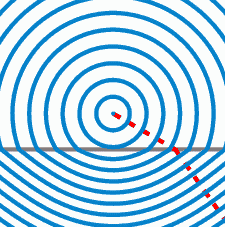Light can
be reflected and refracted. To understand a mirage you must first
understand how temperature affects the path light takes. If light
travels through constant temperature then it will travel in a straight
line. Considering light as a photon it makes sense that these photons
would take the shortest path. Much like electricity takes the path of
least resistance. Cold air has a higher index of refraction than hot
air does. This is due to the fact that cold air is more dense than hot
air and light travels slower through it.
http://www.phy.cuhk.edu.hk/phyworld/iq/mirage/mirage_1_e.gif
 http://upload.wikimedia.org/wikipedia/commons/d/dc/Snells_law_wavefronts.gif
http://upload.wikimedia.org/wikipedia/commons/d/dc/Snells_law_wavefronts.gif
Air does not have uniform temperature. In fact it
has layers of different temperatures that get lower as you climb in
height. The picture above illustrates the path that light takes during
an average mirage. In the case of a mirage you notice that the angle of
refraction is greater than the angle of incidence. This bending of
light makes you see the sky where there should be sand. Providing the
illusion of water.